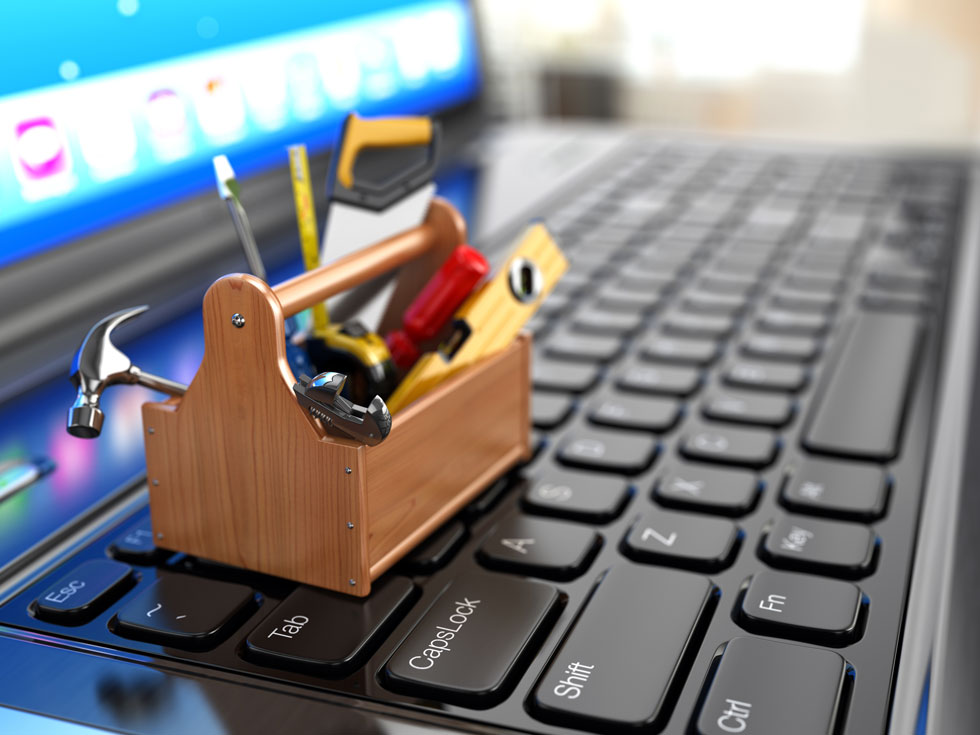Laptops are essential tools in our daily lives, whether for work, study, or entertainment.
However, like any other electronic device, they can encounter problems. If you know some useful laptop troubleshooting, you’ll fix these little ‘troubles’ on your own.

Here’s a guide to troubleshooting some of the most common laptop issues:
1. Laptop won’t turn on.
Symptoms:
- No power lights.
- No fan noise.
- Black screen.
Troubleshooting steps:
- Check power source: Ensure the power adapter is plugged in, and the outlet is working. Try a different outlet or power adapter if possible.
- Remove the battery: If your laptop has a removable battery, take it out and hold the power button for 30 seconds. Then, plug in the power adapter and try to turn it on.
- Check for loose connections: Ensure all connections are secure. Sometimes, a loose connection can prevent the laptop from powering up.
- Perform a hard reset: For laptops with a non-removable battery, hold the power button for about 10–15 seconds to perform a hard reset.
2. Performance is slow or lagging.
Symptoms:
- Lagging response.
- Slow boot times.
- Applications taking too long to load.
Troubleshooting steps:
- Close unnecessary programs: Too many programs running at once can slow down your laptop. Close any programs or browser tabs you’re not using.
- Check for malware and viruses: Run a full system scan using antivirus software to check for malware or viruses. Also keep your Windows Defender or similar antivirus updated.
- Free up disk space: Delete unnecessary files and uninstall unused programs. Use the built-in disk cleanup tool to remove temporary files.
- Upgrade hardware: Consider upgrading your RAM or switching to an SSD if your laptop is older and has limited memory or a traditional hard drive.
3. Overheating.
Symptoms:
- Hot to the touch.
- Loud fan noise.
- Unexpected shutdowns.
Troubleshooting steps:
- Clean the vents: Dust can block the cooling vents. Use compressed air to clean the vents and fans.
- Use a cooling pad: A laptop cooling pad can help dissipate heat more effectively.
- Check for background processes: Some processes can cause the CPU to overheat. Use the task manager to check for and end high CPU usage processes.
- Reapply thermal paste: If you’re comfortable with hardware, reapplying thermal paste on the CPU can improve heat dissipation.
4. Battery issues.
Symptoms:
- Battery drains quickly.
- Laptop only works when plugged in.
- Battery not charging.
Troubleshooting steps:
- Check power settings: Adjust your power settings to improve battery life. Reduce screen brightness and disable unused hardware like Bluetooth.
- Calibrate the battery: Fully charge the battery, then use the laptop until it shuts down. Fully charge it again without interruption.
- Replace the battery: If your battery is old, it might need replacing. Check with your laptop manufacturer for a compatible replacement.
5. Wi-Fi connectivity issues.
Symptoms:
- Unable to connect to Wi-Fi.
- Intermittent connection.
- Slow internet speeds.
Troubleshooting steps:
- Restart router and laptop: Sometimes, a simple restart can fix connectivity issues.
- Forget and reconnect to network: Go to your network settings, forget the Wi-Fi network, and reconnect.
- Update drivers: Ensure your wireless network drivers are up-to-date. Check the manufacturer’s website for the latest drivers.
- Check for interference: Other electronic devices can interfere with Wi-Fi signals. Ensure there are no obstructions between your laptop and the router.
6. Display issues.
Symptoms:
- Flickering screen.
- Blank or black screen.
- Distorted images.
Troubleshooting steps:
- Check connections: If using an external monitor, ensure all cables are securely connected.
- Adjust resolution: Go to display settings and adjust the resolution to match your screen’s native resolution.
- Update graphics drivers: Outdated or corrupt graphics drivers can cause display issues. Update them through the device manager or the manufacturer’s website.
- Test with external monitor: Connect your laptop to an external monitor. If the external display works, the problem may be with your laptop screen.
7. Sound issues.
Symptoms:
- No sound.
- Distorted or crackling sound.
- Audio playing through wrong device.
Troubleshooting steps:
- Check volume settings: Ensure the volume is not muted and is set at an appropriate level.
- Select correct audio device: Go to sound settings and ensure the correct playback device is selected.
- Update audio drivers: Outdated audio drivers can cause sound problems. Update them through the device manager or the manufacturer’s website.
- Test with headphones: Plug in headphones to see if sound plays through them. If it does, the issue may be with your laptop’s speakers.
8. Keyboard not working.
Symptoms:
- Unresponsive keys.
- Keys typing incorrect characters.
- Entire keyboard not working.
Troubleshooting steps:
- Clean the keyboard: Dust and debris can cause keys to malfunction. Use compressed air to clean the keyboard.
- Check keyboard settings: Ensure your keyboard settings are correct, and the correct input language is selected.
- Update keyboard drivers: Outdated drivers can cause keyboard issues. Update them through the device manager.
- Use an external keyboard: If an external keyboard works, the issue may be with your laptop’s built-in keyboard.
By following these troubleshooting steps, you can resolve many common laptop problems on your own. If the issue persists, it may be time to consult a professional technician or consider contacting the laptop manufacturer for further assistance.
Leave a Reply